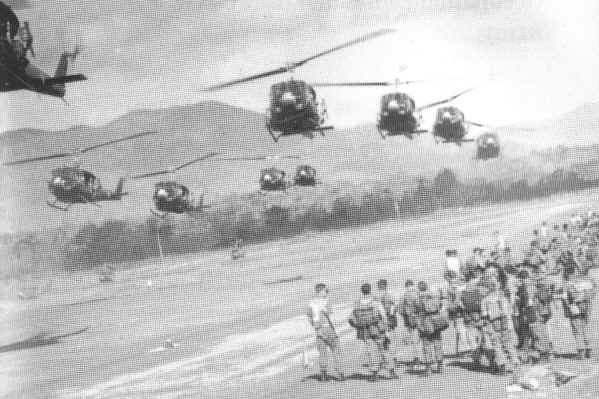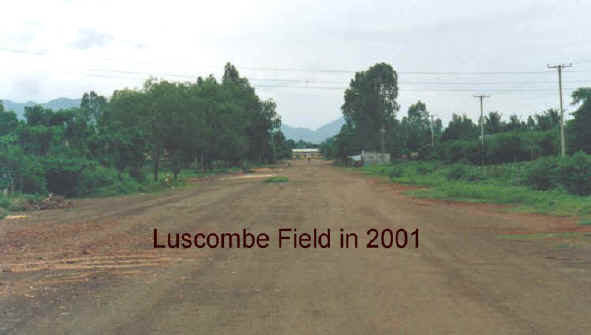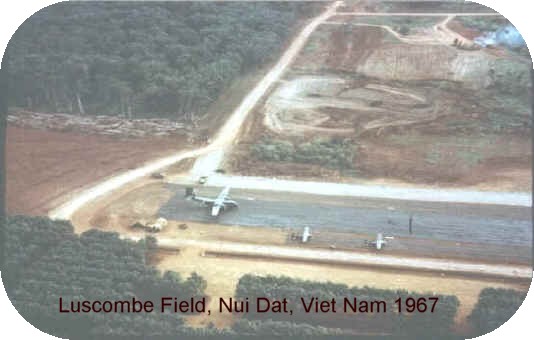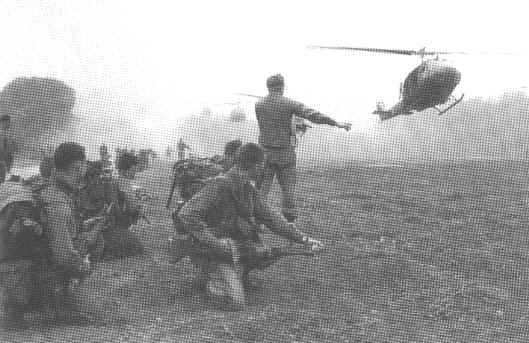|
The First Australian Task
Force (1ATF) moved into the Nui Dat area in early June 1966, and units
were deployed so that a compromise was struck between immediate and future
requirements. On the one hand was a need for a fairly compact defensive
layout around the Nui Dat feature; on the other was the requirement for
early development of domestic roads, and provision of adequate empty
spaces for eventual construction of essential buildings and installations.
Not the least important of these installations was an airfield.
With the wet monsoon season
imminent, top priority for engineer base development effort was directed
to construction of scale 'A' accommodation and access service roads to
units, in the hope that units would not become mud-bound in their
essential domestic activities.
During the early stages of
development of Nui Dat it was necessary for 161 (Indep) Recce Flt, a Task
Force unit, to remain at Vung Tau with the First Australian Logistic
Support Group (1ALSG), since the fixed wing light aircraft had to use the
Vung Tau airfield.
The initial master plan
made provision for a Caribou standard airfield and a large landing area
for helicopters, in addition to other facilities. Sites for the airfield
and the main helipad were selected by 1 Field Squadron (RAE) based on the
Task Force Commander's tactical and logistical requirements, the ruling
airfield criteria provided by Military Aid Command Vietnam (MACV), and
local advice from RAAF.
In the initial laying out
of the Task Force, three large tracts were left vacant within the area to
provide for the airfield and a major heliport. Since all three of these
areas were naturally fairly low and virtually below the wet monsoon high
water mark, they were not attractive for the initial development.
Since engineer effort was
directed to other tasks and since the wet season had commenced,
reclamation could not be attempted at that time. Between the Nui Dat
feature (SAS Hill) and the Task Force rubber plantation was a natural
cleared area which was used initially as the main helipad, and was known
as Kangaroo Pad. By means of fairly substantial drainage and excavation,
this area could be converted to a large heliport running east-west, or,
with considerable more effort, a Caribou airfield with a number of fairly
stringent restrictions.
The proximity to TF HQ and
the extensive earthworks requirement for an airfield made this area better
suited to ultimate development as a heliport. The two main areas which
were considered for the airfield were:
1. To the
west of Nui Dat using Route 2 as a centre line (running north-south), and
located between 5RAR in the north and TF HQ in the south, or
2. To the
north of Nui Dat just south of the rubber plantation which was occupied by
5RAR and to the east of Route 2, oriented east-west.
The former location offered
several advantages in the short term - the alignment was already fairly
clear of vegetation; the road provided a ready-made (though narrow)
runway, which could be widened and graded smooth; the entire runway would
be dominated by the Nui Dat feature; and the ends secured by Task Force
units; the airfield would be centrally placed for easy access from all
units.
 |
Luscombe airfield, Vietnam. 1968-01-23.
Soldiers from fire assault platoon Support Company, 7th battalion,
the Royal Australian regiment (7RAR), moving along Luscombe airstrip
prior to transfer by helicopter at the start of operation Coburg.
Left to right: 38965 Corporal Bill Fogarty with self loading rifle,
m79 40mm grenade launcher and the cylinder on his pack which is a
splintrex round for the 90mm recoilless rifle (rcl), Private Ross
Hollings with the m67 90mm recoilless rifle (rcl), a self loading
rifle and one splintrex round under his pack, Private Stephen Craig,
Lance Corporal Robert Hite and Corporal Kevin Hawkins. (donor H.
Clement) |
Many disadvantages were
apparent, however, particularly in the long term. The alignment was at
right angles to the prevailing wind directions, these being east to west
from November to February and west to east from April to September. The
flight path of fixed wing aircraft would cross that of helicopters using
Kangaroo Pad. The western flank of the entire length of the runway would
be exposed to enemy observation and possibly direct fire from Nui Thi Vai
Hills to the west. In addition this flank was vulnerable to enemy ground
attack since there were no friendly units located west of Route 2 in this
area. Immediate approaches from both ends were over rising ground and
gradients along the centre line were too great for ultimate use by
aircraft larger than Caribou.
If excavation had to be
done, the advantage of the ready-made runway was negated. Drainage for
subsequent expansion of parking areas and service areas would be a major
task, as there were two perennial streams crossing the road in this area.
If Route 2 were used for the airfield it would be necessary to construct a
bypass road so that civilians to the north could get produce to the
markets in Baria and Vung Tau.
Consideration of these, and
other relatively minor factors pointed to the ultimate location as the
most suitable. This site too, presented some problems. Although most of
the proposed area was only lightly covered with young rubber trees and
scrub, the northern and eastern boundaries were covered with tall rubber,
up to 45 feet in height - which provided cover for elements of 5RAR and
6RAR respectively. There was quite a pronounced cross-slope from the 5RAR
area on the north side to a perennial watercourse running parallel with
the proposed runway to the south.
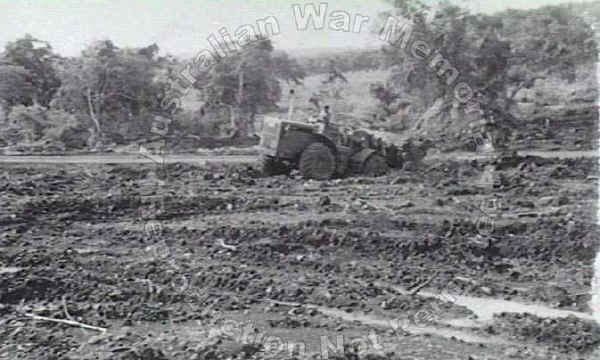
The space between 5RAR and
the stream was obviously restrictive for proper lateral cleared zones. The
pronounced cross-slope indicated a requirement for substantial drainage
structures to carry run-off from 5RAR to the stream. The approach glide
path from the west was across unoccupied ground to the west of Route 2,
and the western end of the runway could be observed from the Nui Thi
Vai's. Eventual extension of the airfield to C130 Hercules standard would
involve crossing Route 2 to extend the runway proper into unoccupied
ground to the west. Notwithstanding these shortcomings, the advantages (or
minimal disadvantages) made this site the most attractive for the Task
Force air-head.
During the first three or
four months, while the bulk of the engineer construction effort was
diverted elsewhere, there was little work done on the airfield site. Since
the 5RAR area needed major monsoon drains to carry away run-off, these
were constructed at proper levels, and in the right positions to fit into
the drainage plan of the future airfield. To permit earthworks to continue
at a later date, two 48-inch diameter corrugated iron culverts were
installed under the runway alignment, each one being 150 feet long. Some
clearing of the site was demanded during this period to permit
construction of the northern limb of Canberra Avenue, which ran parallel
to the airfield and provided major access to 5RAR. From time to time some
additional patchy work was accomplished when machines were precluded from
working on priority jobs by bad weather.
As essential base
development work had progressed well since June, priority of engineer
effort was directed to the construction of a Caribou airfield in
mid-October 1966. 1ATF operations were ranging further afield, and placing
heavier demands on the limited available helicopter support for daily
resupply from Nui Dat to forward operational bases. The Task Force
Reconnaissance Flight was still located in Vung Tau.
A detailed survey of the
site revealed a dilemma for the airfield designers. Between Route 2 in the
west and the 6RAR rubber plantation in the east there was more than
sufficient length for a Caribou strip. There was, however, a total rise of
50 feet, with several natural hollows and bumps over the length of
approximately 3,000 feet.
After consultation with the
RAAF, it was decided to accept the overall fall and adapt operating
procedures to allow for it. It was decided that aircraft would generally
land up-hill (towards the east), and take off down-hill exploiting the
assistance of gravity, and avoiding a glide path over the 6RAR area. On
the rare occurrences of strong easterly winds, procedures might have to be
modified.
In order to minimize
excavation it was considered satisfactory to accept relatively large
percentage changes in longitudinal gradients, provided they were within
the limits of the MACV criteria - hence the dips and bumps in the airfield
- not designed to provide ski-jump take-off assistance, as was suggested
by one early passenger.
A Caribou airfield would
not require the full 3,000 feet which was available, so it was decided to
attempt to construct the field to meet requirements of MACV criteria for
limited use by C130 aircraft. The unique operating procedures made it
possible to do this, since the over-run at the eastern end could be
converted to extra runway. The runway could be extended at a later stage
to the west of Route 2, to measure up, with some minor restrictions, to
the standards for a fully operational C130 airfield.
From the engineering point
of view, it was desirable to accomplish earthworks as quickly as possible.
Disregarding the formidable list of other tasks on the job-priority table,
it was desirable to cut, fill, and compact the earthworks during the
period between the wet monsoon and the dry season. It was hoped that it
would be possible to work the soil at close to optimum moisture content,
thus minimizing the need to haul and spread water for compaction, and for
dust laying.
The plant operators of 21
Engineer Support Troop RAE, under command of 1 Field Squadron, responded
to the challenge in characteristic sapper fashion. Earthmoving equipment
operated from daylight till dark, clearing, cutting, hauling and
compacting. With the end of the wet season the soil quickly lost its
moisture, and it became necessary to spread water to ensure adequate
compaction.
Improvised water tanks were
constructed by reinforcing and lining large packing cases which had
contained prefabricated metal buildings. Water was distributed and the
airfield was rolled in pre-dawn darkness to minimize evaporation losses
and to exploit overnight condensation. This operation was made possible by
the co-operation of the APC squadron and the infantry battalions who
provided standing patrols to the west of Route 2, while engineers worked
in darkness.
After about 50,000 cubic
yards of soil had been excavated and the flight-strip had been graded and
compacted, a covering of locally won laterite was laid over the runway and
shoulders. The runway proper was clad with high quality leached laterite
which was extracted from a quarry between 1ATF and Hoa Long. Some 5,000
cubic yards of this material were imported to provide a 9-inch thick
compacted pavement on the 80 feet wide runway.
On 31 October a Cessna 180
from 161 (Indep) Recce Flt conducted several 'proof landings' on the
airfield, though it was far from complete at this stage. The purpose was
twofold. The landings confirmed that the runway could be used in
emergencies from that date. Plant operators working on the site had
noticed FAC aircraft of the US Air Force doing low-level runs over the
cleared area. While engineer graders and excavators pre-empted an American
inaugural landing on the strip, a hasty engineer/aviation reconnaissance
was arranged and a Cessna 180 was diverted from Baria to conduct the proof
landings. By late November, the airfield was ready for inspection by USAF
representatives.
They required the removal
of some 400 rubber trees from the eastern end of the airfield in order to
certify the field suitable for use by Caribou and C123 and by C130 with
Grade A pilots. This additional work was completed in time for the
official opening of the field on 5 December 1966, the completion date
which had been forecast in early October. At this stage the airfield was
regarded as dry weather strip - since traffic during wet weather could
damage the surface.
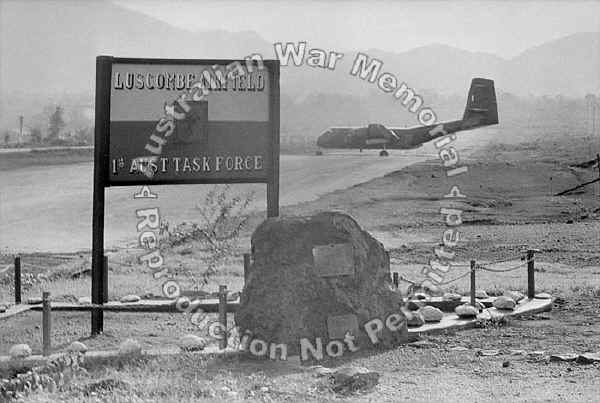
A simple opening ceremony
took place on 5 December before a small guard of honour of engineers and
Army aviators, flanked by light aircraft and earthmoving equipment.
Brigadier Oliver David Jackson, Commander 1 ATF, unveiled a commemorative
plaque, naming the airfield 'Luscombe Field'. A Caribou of 35 Squadron
(RAAF) landed on the runway, using only a small part of the total length
available.
Later in December the
runway was sealed with 'Peneprime', a bituminous dust palliative. In the
absence of crushed rock, sand was used with the bitumen. Even spreading
was difficult to achieve without special equipment, and a technique was
developed whereby hovering helicopters spread the sand and blew away
excess material from the sealed strip. Repeated applications created a
waterproof skin which enabled Luscombe Field to be used throughout the
following wet season without damage.
1 Field Squadron (RAE)
built workshops, parking areas, and accommodation for 161 (Indep) Recce
Flt in the rubber trees adjacent to the northern edge of the airfield, at
the eastern end. Pre-fabricated metal airfield matting was laid over a
plastic membrane to give a waterproof, dust free, parking and working area
in the shelter of the rubber plantation. Aircraft parking areas were
constructed on the south side of the runway, and a new Task Force
Maintenance Area was built between Nui Dat and 6RAR, to the south of the
airfields.
Development progressed
continuously until December 1968 when engineers of the US 34 Engineer
Group extended Luscombe Field to 4,100 feet and permanently sealed the
whole runway. The pavement of the extension was made from locally won
crushed rock and it had been intended to sheath the entire runway with
similar material. Since the existing runway had shown no signs of failure
or weakness at any time, and since the existing pavement was obviously
adequate to the task, the runway re-construction plan was abandoned as
unnecessary.
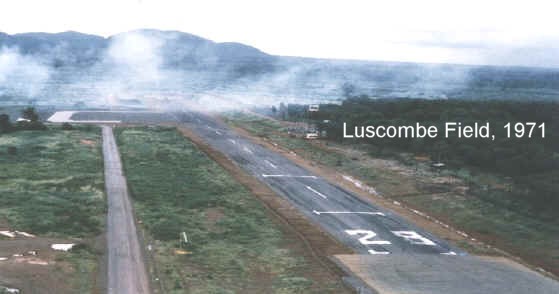
Luscombe Field was probably
taken for granted by most new arrivals to the Task Force area at Nui Dat.
An airfield is to be expected in a well developed task force base.
Probably the only comments which were aroused were those which questioned
the peculiarities of the airfield or those which wondered where it got its
name.
Luscombe Field was a
monument to much more than Captain Luscombe. It represented many aspects
of the part played by the Australian Force in Vietnam. It contributed to
the connecting link between the Task Force and its supporting units and
commanding HQ. It was the 'front door' of 1 ATF through which thousands of
men passed, going to and coming from the war. |

